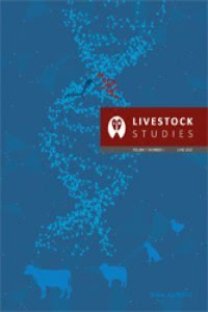HOLŞTAYN SIĞIRLARDA, PUBERTADAN SONRA FARKLI SÜRELERDE SINIRLI YEMLEMENİN BES PERFORMANSI, KESİM-KARKAS ÖZELLİKLERİ VE BESİ MALİYETİNE ETKİSİ
Bu çalışma, Holştayn ırkı sığırlarda pubertadan sonra sınırlı besleme süresinin besi performansı, kesim-karkas özellikleri ve besi maliyetine etkisini belirlemek amacıyla yapılmıştır. Araştırmada, ortalama 9 aylık yaşta toplam 99 baş erkek dana kullanılmıştır. Kontrol (G-I), 3 ay (G-II) ve 6 ay (G-III) sınırlı besleme gruplarında besi başı ağırlıkları sırasıyla; 246.23±3.61, 248.41±4.52 ve 245.40±4.68 kg; besi sonu ağırlıkları aynı sırayla; 479.30± 6.78, 477.55±8.33 ve 478.80±8.56 kg olmuştur. Hedeflenen besi sonu ağırlığına G-I 240, G-II 248 ve G-III 276 günde ulaşmıştır. Besi başından G-I’ in kesildiği 240. güne kadar olan aylık dönemlerin tamamında gruplar arasındaki farklılık yüksek düzeyde önemli bulunmuştur r (P<0.001). Besi süresince gruplarda günlük canlı aırlık artıı sırasıyla; 0.97±0.03, 0.92±0.17 ve 0.85±0.12 kg olarak bulunmutur. Besinin aylık dönemlerinde gruplar arasındaki farklılıklar önemli olmutur (P<0.01, P<0.001). Besi süresince gruplardaki günlük toplam kuru madde tüketimi sırasıyla; 9.26, 9.45 ve 8.40 kg; konsantre kuru madde tüketimi ise 7.24, 6.68 ve 5.24 kg olarak gerçeklemitir. Toplam kuru madde cinsinden yemden yararlanma deerleri gruplarda sırasıyla; 9.55, 10.27 ve 9.88; konsantre kuru madde cinsinden ise aynı sırayla; 7.46, 7.26 ve 6.16 olmutur. Kesim aırlıkları gruplarda sırasıyla; 459.28, 458.07 ve 455.93 kg, sıcak karkas randımanı aynı sırayla % 56.60, 56.26 ve 55.62 olarak tespit edilmitir. Gruplar arasında farklılık bulunmamaktadır (P>0.05). Kısmi Bütçe Analizinde cari fiyatlarla yapılan hesaplamalarda gelir-gider farkları gruplarda sırasıyla; 1629.64, 1611.09 ve 1697.19 YTL olarak bulunmutur. Aratırma bulguları, yem maliyetinin toplam masraflar içerisinde en yüksek paya sahip olması, yem ve karkas fiyatlarında dönem dönem dalgalanmalar görülmesi nedeniyle sınırlı beslemeden ekonomik bir ekilde yararlanılabileceini göstermektedir.
Anahtar Kelimeler:
Besi Maliyeti, Besi Performansı, Holştayn, Karkas, Puberta, Sığır, Sınırlı Yemleme
The Effect of Restricted Feeding in Different Duration on Fattening Performance, Slaughtering-Carcas Characteristics and Fattening Cost on Holstein Cattle after Puberty
It was aimed to determine the effect of restricted feeding in different duration on fattening performance, slaughtering-carcas characteristics and fattening cost on Holstein Cattle after puberty. The study was conducted in a private farm in Kır ehir province where steppe climate conditions prevail. A total of 99 head of Holstein male veal, 9 months of age, were used. The veals were assigned to three experimental groups; Group I (control), Group II (applied restricted feeding for 3 months), Group III (applied restricted feeding for 6 months). The average values of initial live weight of G-I, G-II and G-III were determined as 246.23±3.61, 248.41±4.52 and 245.40±4.68 kg, respectively. The finishing live weight of these groups were detected as 479.30± 6.78, 477.55±8.33 and 478.80±8.56 kg, respectively. G-I, G-II and G-III were reached at targeted finishing live weight 240, 248 and 276 days after starting of fattening. The differences amonggroups were found statistically significant from the start of the fattening period to 240 days that G-I was slaughtered (P<0.001). Daily live weight gain were determined as 0.97±0.03, 0.92±0.17 and0.85±0.12 kg throughout fattening period for G-I, G-II and G-III, respectively. The differences among groups were found statistically significant at monthly periods of * Bu çalı ma doktora tezinden özetlenmi tir.fattening (P<0.01, P<0.001). Daily total dry matter consumption in groups were detected as 9.26, 9.45 and 8.40 kg; concentrate dry matter consumption in groups were found as 7.24, 6.68 and 5.24 kg, respectively. Feed efficiency values based on total dry matter were determined as 9.55, 10.27 and 9.88 while corresponding values based on concentrate dry matter were 7.46, 7.26 and 6.16 for G-I, G-II and G-III, respectively. Means for slaughter weight of groups were 459.28, 458.07 and 455.93 kg; hot dressing percentage of the groups were 56.60, 56.26 and 55.62 % (P>0.05), respectively. The revenue-expenditure differences were detected as 1629.64, 1611.09 and 1697.19 YTL (New Turkish Lira) from the calculations using years of 2006 prices by the Partial Budget Analyze Method in groups, respectively. In conclusion, because of the highest ratio of feeding cost in total fattening cost and price fluctuations of feeds, restricted feeding could be useful during cattle fattening economically
Keywords:
Carcass, Cattle, Fattening Cost, Fattening Performance, Holstein, Puberty, Restricted Feeding.,
- Yayın Aralığı: Yılda 2 Sayı
- Başlangıç: 1959
- Yayıncı: Sezer ÖZ
